Sustainable Innovation Business Models
VerifiedAdded on 2020/01/23
|17
|5873
|34
Essay
AI Summary
This assignment delves into the realm of sustainable innovation business models. It examines current research advancements in this field and outlines a roadmap for future scholarly inquiry. Students are tasked with analyzing existing models, identifying gaps in knowledge, and proposing avenues for further investigation. The objective is to contribute to a comprehensive understanding of how businesses can integrate sustainability into their core operations and create value while minimizing environmental impact.
Contribute Materials
Your contribution can guide someone’s learning journey. Share your
documents today.

BUSINESS AND BUSINESS
ENVIRONMENT
1
ENVIRONMENT
1
Secure Best Marks with AI Grader
Need help grading? Try our AI Grader for instant feedback on your assignments.
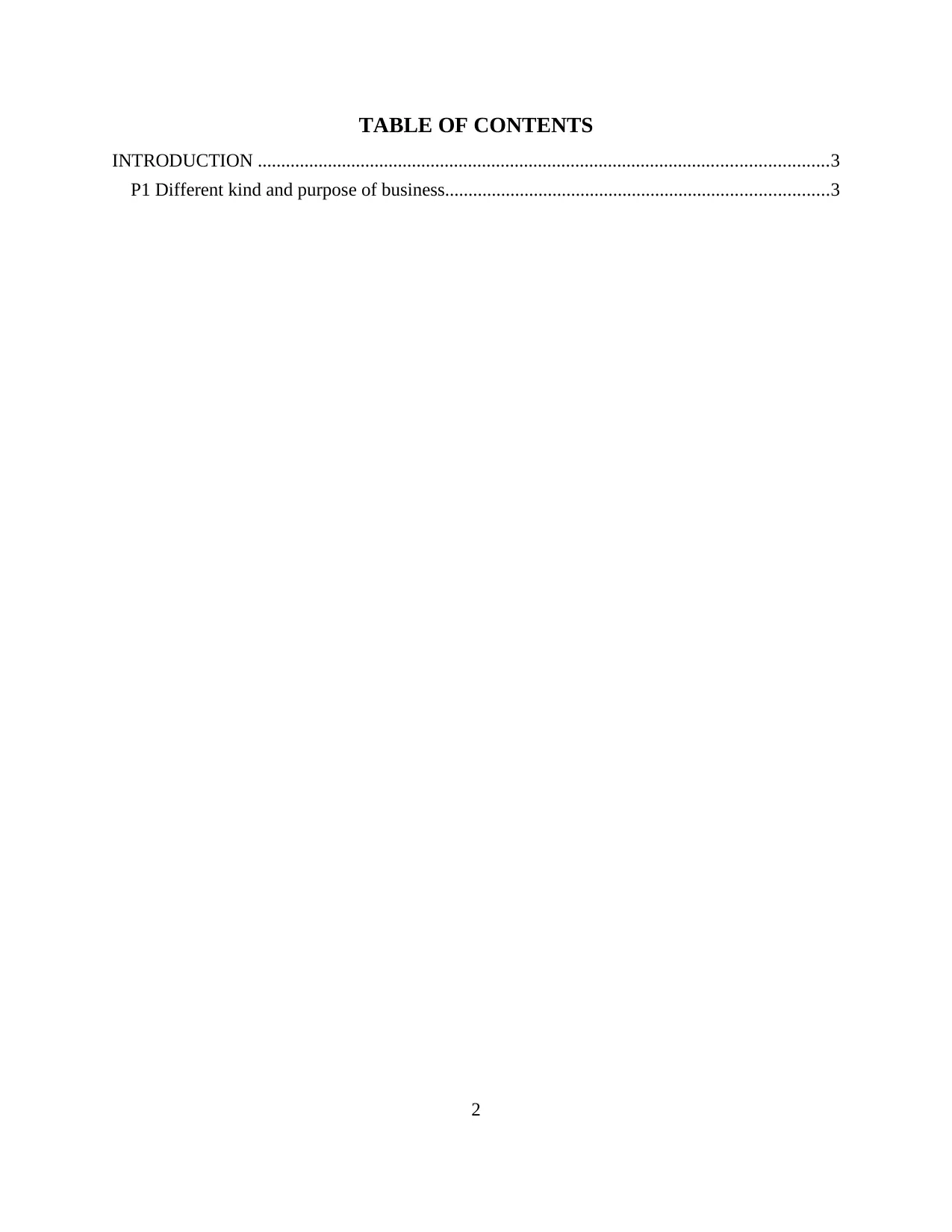
TABLE OF CONTENTS
INTRODUCTION ..........................................................................................................................3
P1 Different kind and purpose of business..................................................................................3
2
INTRODUCTION ..........................................................................................................................3
P1 Different kind and purpose of business..................................................................................3
2
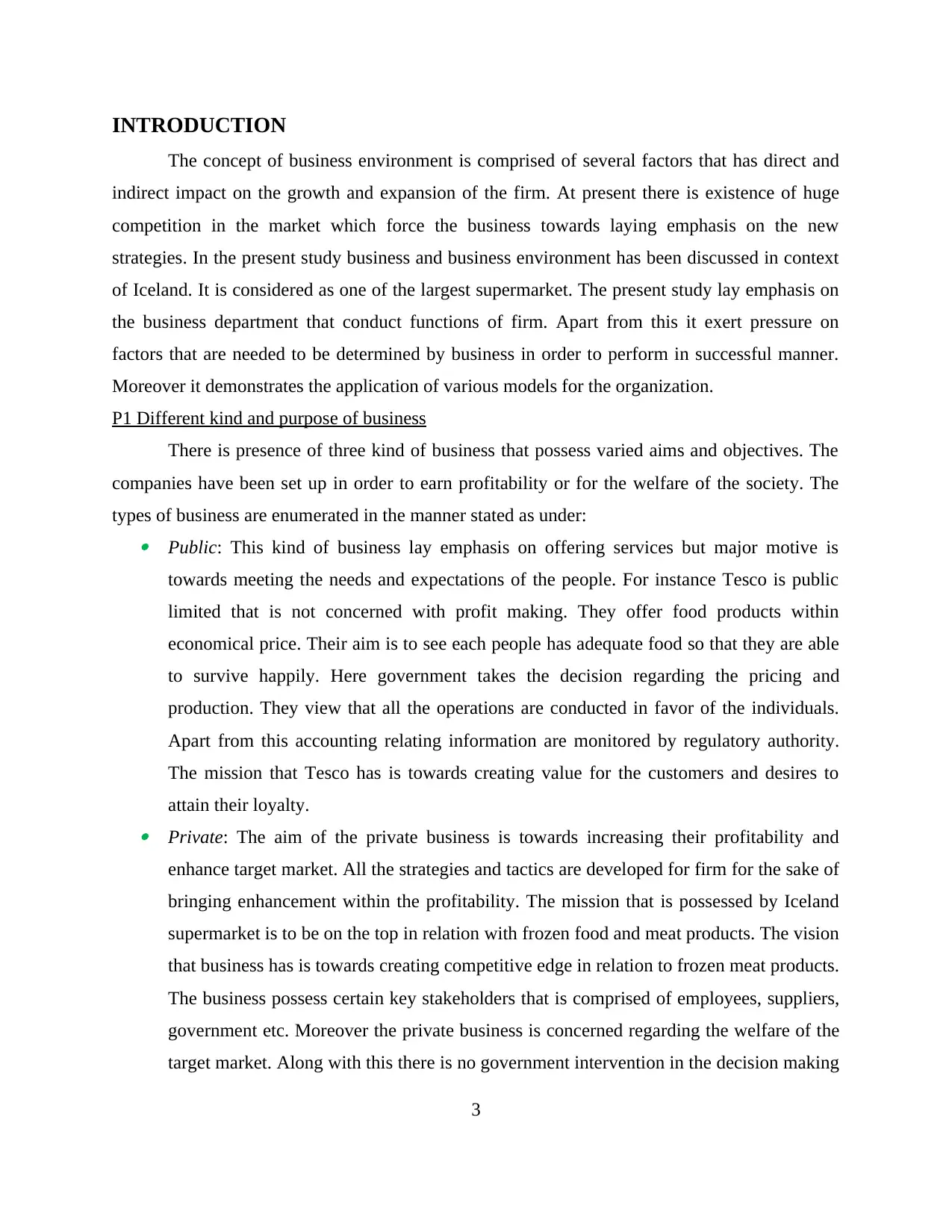
INTRODUCTION
The concept of business environment is comprised of several factors that has direct and
indirect impact on the growth and expansion of the firm. At present there is existence of huge
competition in the market which force the business towards laying emphasis on the new
strategies. In the present study business and business environment has been discussed in context
of Iceland. It is considered as one of the largest supermarket. The present study lay emphasis on
the business department that conduct functions of firm. Apart from this it exert pressure on
factors that are needed to be determined by business in order to perform in successful manner.
Moreover it demonstrates the application of various models for the organization.
P1 Different kind and purpose of business
There is presence of three kind of business that possess varied aims and objectives. The
companies have been set up in order to earn profitability or for the welfare of the society. The
types of business are enumerated in the manner stated as under: Public: This kind of business lay emphasis on offering services but major motive is
towards meeting the needs and expectations of the people. For instance Tesco is public
limited that is not concerned with profit making. They offer food products within
economical price. Their aim is to see each people has adequate food so that they are able
to survive happily. Here government takes the decision regarding the pricing and
production. They view that all the operations are conducted in favor of the individuals.
Apart from this accounting relating information are monitored by regulatory authority.
The mission that Tesco has is towards creating value for the customers and desires to
attain their loyalty. Private: The aim of the private business is towards increasing their profitability and
enhance target market. All the strategies and tactics are developed for firm for the sake of
bringing enhancement within the profitability. The mission that is possessed by Iceland
supermarket is to be on the top in relation with frozen food and meat products. The vision
that business has is towards creating competitive edge in relation to frozen meat products.
The business possess certain key stakeholders that is comprised of employees, suppliers,
government etc. Moreover the private business is concerned regarding the welfare of the
target market. Along with this there is no government intervention in the decision making
3
The concept of business environment is comprised of several factors that has direct and
indirect impact on the growth and expansion of the firm. At present there is existence of huge
competition in the market which force the business towards laying emphasis on the new
strategies. In the present study business and business environment has been discussed in context
of Iceland. It is considered as one of the largest supermarket. The present study lay emphasis on
the business department that conduct functions of firm. Apart from this it exert pressure on
factors that are needed to be determined by business in order to perform in successful manner.
Moreover it demonstrates the application of various models for the organization.
P1 Different kind and purpose of business
There is presence of three kind of business that possess varied aims and objectives. The
companies have been set up in order to earn profitability or for the welfare of the society. The
types of business are enumerated in the manner stated as under: Public: This kind of business lay emphasis on offering services but major motive is
towards meeting the needs and expectations of the people. For instance Tesco is public
limited that is not concerned with profit making. They offer food products within
economical price. Their aim is to see each people has adequate food so that they are able
to survive happily. Here government takes the decision regarding the pricing and
production. They view that all the operations are conducted in favor of the individuals.
Apart from this accounting relating information are monitored by regulatory authority.
The mission that Tesco has is towards creating value for the customers and desires to
attain their loyalty. Private: The aim of the private business is towards increasing their profitability and
enhance target market. All the strategies and tactics are developed for firm for the sake of
bringing enhancement within the profitability. The mission that is possessed by Iceland
supermarket is to be on the top in relation with frozen food and meat products. The vision
that business has is towards creating competitive edge in relation to frozen meat products.
The business possess certain key stakeholders that is comprised of employees, suppliers,
government etc. Moreover the private business is concerned regarding the welfare of the
target market. Along with this there is no government intervention in the decision making
3
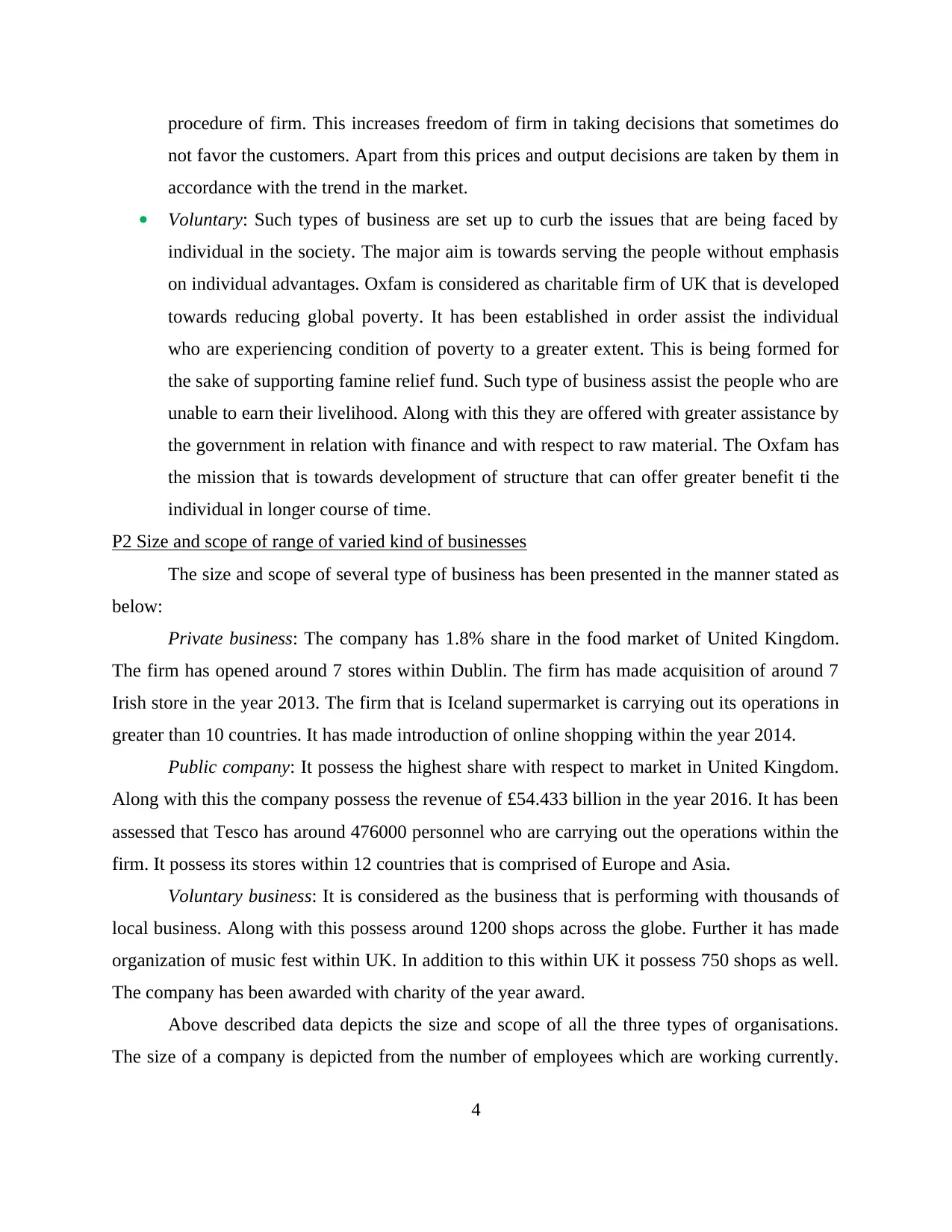
procedure of firm. This increases freedom of firm in taking decisions that sometimes do
not favor the customers. Apart from this prices and output decisions are taken by them in
accordance with the trend in the market.
Voluntary: Such types of business are set up to curb the issues that are being faced by
individual in the society. The major aim is towards serving the people without emphasis
on individual advantages. Oxfam is considered as charitable firm of UK that is developed
towards reducing global poverty. It has been established in order assist the individual
who are experiencing condition of poverty to a greater extent. This is being formed for
the sake of supporting famine relief fund. Such type of business assist the people who are
unable to earn their livelihood. Along with this they are offered with greater assistance by
the government in relation with finance and with respect to raw material. The Oxfam has
the mission that is towards development of structure that can offer greater benefit ti the
individual in longer course of time.
P2 Size and scope of range of varied kind of businesses
The size and scope of several type of business has been presented in the manner stated as
below:
Private business: The company has 1.8% share in the food market of United Kingdom.
The firm has opened around 7 stores within Dublin. The firm has made acquisition of around 7
Irish store in the year 2013. The firm that is Iceland supermarket is carrying out its operations in
greater than 10 countries. It has made introduction of online shopping within the year 2014.
Public company: It possess the highest share with respect to market in United Kingdom.
Along with this the company possess the revenue of £54.433 billion in the year 2016. It has been
assessed that Tesco has around 476000 personnel who are carrying out the operations within the
firm. It possess its stores within 12 countries that is comprised of Europe and Asia.
Voluntary business: It is considered as the business that is performing with thousands of
local business. Along with this possess around 1200 shops across the globe. Further it has made
organization of music fest within UK. In addition to this within UK it possess 750 shops as well.
The company has been awarded with charity of the year award.
Above described data depicts the size and scope of all the three types of organisations.
The size of a company is depicted from the number of employees which are working currently.
4
not favor the customers. Apart from this prices and output decisions are taken by them in
accordance with the trend in the market.
Voluntary: Such types of business are set up to curb the issues that are being faced by
individual in the society. The major aim is towards serving the people without emphasis
on individual advantages. Oxfam is considered as charitable firm of UK that is developed
towards reducing global poverty. It has been established in order assist the individual
who are experiencing condition of poverty to a greater extent. This is being formed for
the sake of supporting famine relief fund. Such type of business assist the people who are
unable to earn their livelihood. Along with this they are offered with greater assistance by
the government in relation with finance and with respect to raw material. The Oxfam has
the mission that is towards development of structure that can offer greater benefit ti the
individual in longer course of time.
P2 Size and scope of range of varied kind of businesses
The size and scope of several type of business has been presented in the manner stated as
below:
Private business: The company has 1.8% share in the food market of United Kingdom.
The firm has opened around 7 stores within Dublin. The firm has made acquisition of around 7
Irish store in the year 2013. The firm that is Iceland supermarket is carrying out its operations in
greater than 10 countries. It has made introduction of online shopping within the year 2014.
Public company: It possess the highest share with respect to market in United Kingdom.
Along with this the company possess the revenue of £54.433 billion in the year 2016. It has been
assessed that Tesco has around 476000 personnel who are carrying out the operations within the
firm. It possess its stores within 12 countries that is comprised of Europe and Asia.
Voluntary business: It is considered as the business that is performing with thousands of
local business. Along with this possess around 1200 shops across the globe. Further it has made
organization of music fest within UK. In addition to this within UK it possess 750 shops as well.
The company has been awarded with charity of the year award.
Above described data depicts the size and scope of all the three types of organisations.
The size of a company is depicted from the number of employees which are working currently.
4
Secure Best Marks with AI Grader
Need help grading? Try our AI Grader for instant feedback on your assignments.
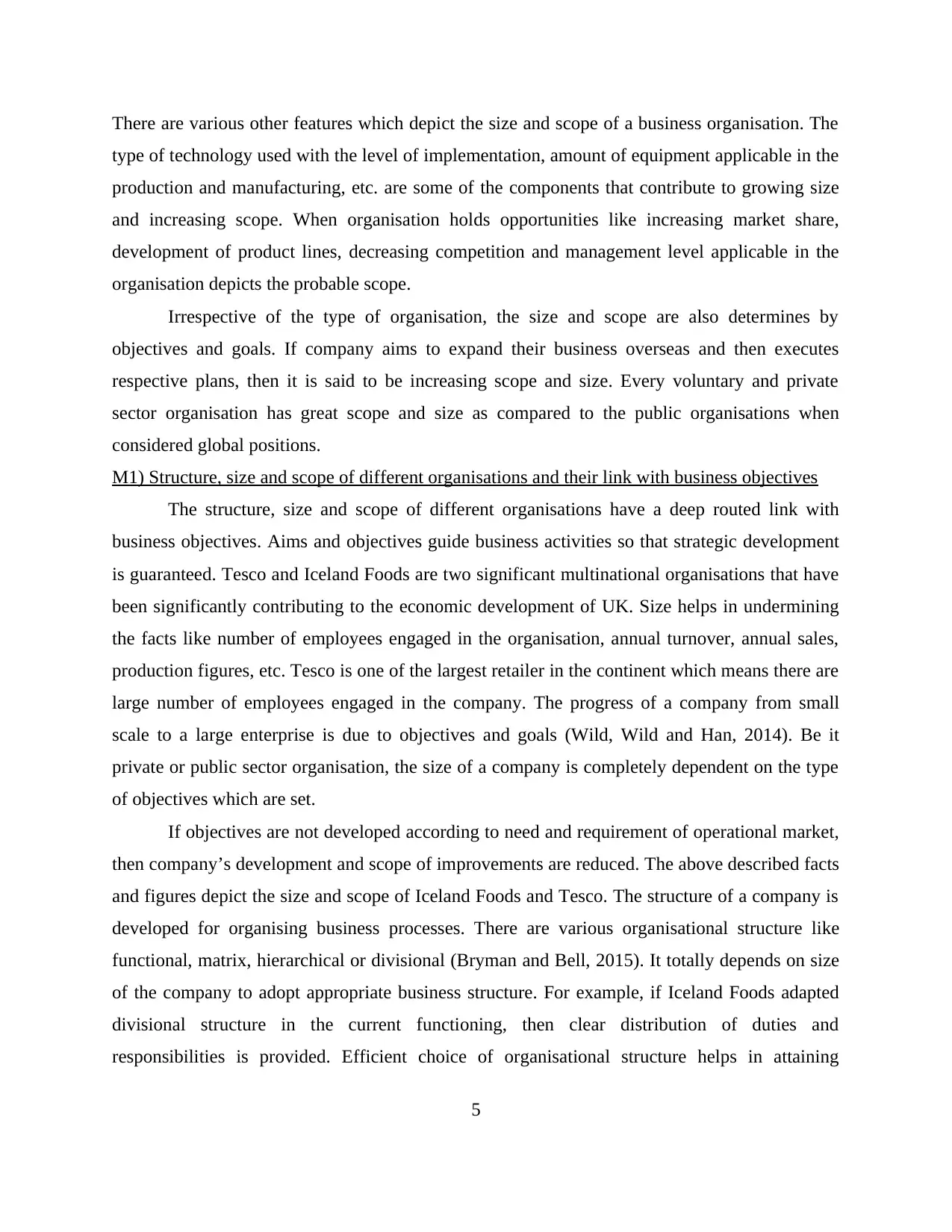
There are various other features which depict the size and scope of a business organisation. The
type of technology used with the level of implementation, amount of equipment applicable in the
production and manufacturing, etc. are some of the components that contribute to growing size
and increasing scope. When organisation holds opportunities like increasing market share,
development of product lines, decreasing competition and management level applicable in the
organisation depicts the probable scope.
Irrespective of the type of organisation, the size and scope are also determines by
objectives and goals. If company aims to expand their business overseas and then executes
respective plans, then it is said to be increasing scope and size. Every voluntary and private
sector organisation has great scope and size as compared to the public organisations when
considered global positions.
M1) Structure, size and scope of different organisations and their link with business objectives
The structure, size and scope of different organisations have a deep routed link with
business objectives. Aims and objectives guide business activities so that strategic development
is guaranteed. Tesco and Iceland Foods are two significant multinational organisations that have
been significantly contributing to the economic development of UK. Size helps in undermining
the facts like number of employees engaged in the organisation, annual turnover, annual sales,
production figures, etc. Tesco is one of the largest retailer in the continent which means there are
large number of employees engaged in the company. The progress of a company from small
scale to a large enterprise is due to objectives and goals (Wild, Wild and Han, 2014). Be it
private or public sector organisation, the size of a company is completely dependent on the type
of objectives which are set.
If objectives are not developed according to need and requirement of operational market,
then company’s development and scope of improvements are reduced. The above described facts
and figures depict the size and scope of Iceland Foods and Tesco. The structure of a company is
developed for organising business processes. There are various organisational structure like
functional, matrix, hierarchical or divisional (Bryman and Bell, 2015). It totally depends on size
of the company to adopt appropriate business structure. For example, if Iceland Foods adapted
divisional structure in the current functioning, then clear distribution of duties and
responsibilities is provided. Efficient choice of organisational structure helps in attaining
5
type of technology used with the level of implementation, amount of equipment applicable in the
production and manufacturing, etc. are some of the components that contribute to growing size
and increasing scope. When organisation holds opportunities like increasing market share,
development of product lines, decreasing competition and management level applicable in the
organisation depicts the probable scope.
Irrespective of the type of organisation, the size and scope are also determines by
objectives and goals. If company aims to expand their business overseas and then executes
respective plans, then it is said to be increasing scope and size. Every voluntary and private
sector organisation has great scope and size as compared to the public organisations when
considered global positions.
M1) Structure, size and scope of different organisations and their link with business objectives
The structure, size and scope of different organisations have a deep routed link with
business objectives. Aims and objectives guide business activities so that strategic development
is guaranteed. Tesco and Iceland Foods are two significant multinational organisations that have
been significantly contributing to the economic development of UK. Size helps in undermining
the facts like number of employees engaged in the organisation, annual turnover, annual sales,
production figures, etc. Tesco is one of the largest retailer in the continent which means there are
large number of employees engaged in the company. The progress of a company from small
scale to a large enterprise is due to objectives and goals (Wild, Wild and Han, 2014). Be it
private or public sector organisation, the size of a company is completely dependent on the type
of objectives which are set.
If objectives are not developed according to need and requirement of operational market,
then company’s development and scope of improvements are reduced. The above described facts
and figures depict the size and scope of Iceland Foods and Tesco. The structure of a company is
developed for organising business processes. There are various organisational structure like
functional, matrix, hierarchical or divisional (Bryman and Bell, 2015). It totally depends on size
of the company to adopt appropriate business structure. For example, if Iceland Foods adapted
divisional structure in the current functioning, then clear distribution of duties and
responsibilities is provided. Efficient choice of organisational structure helps in attaining
5
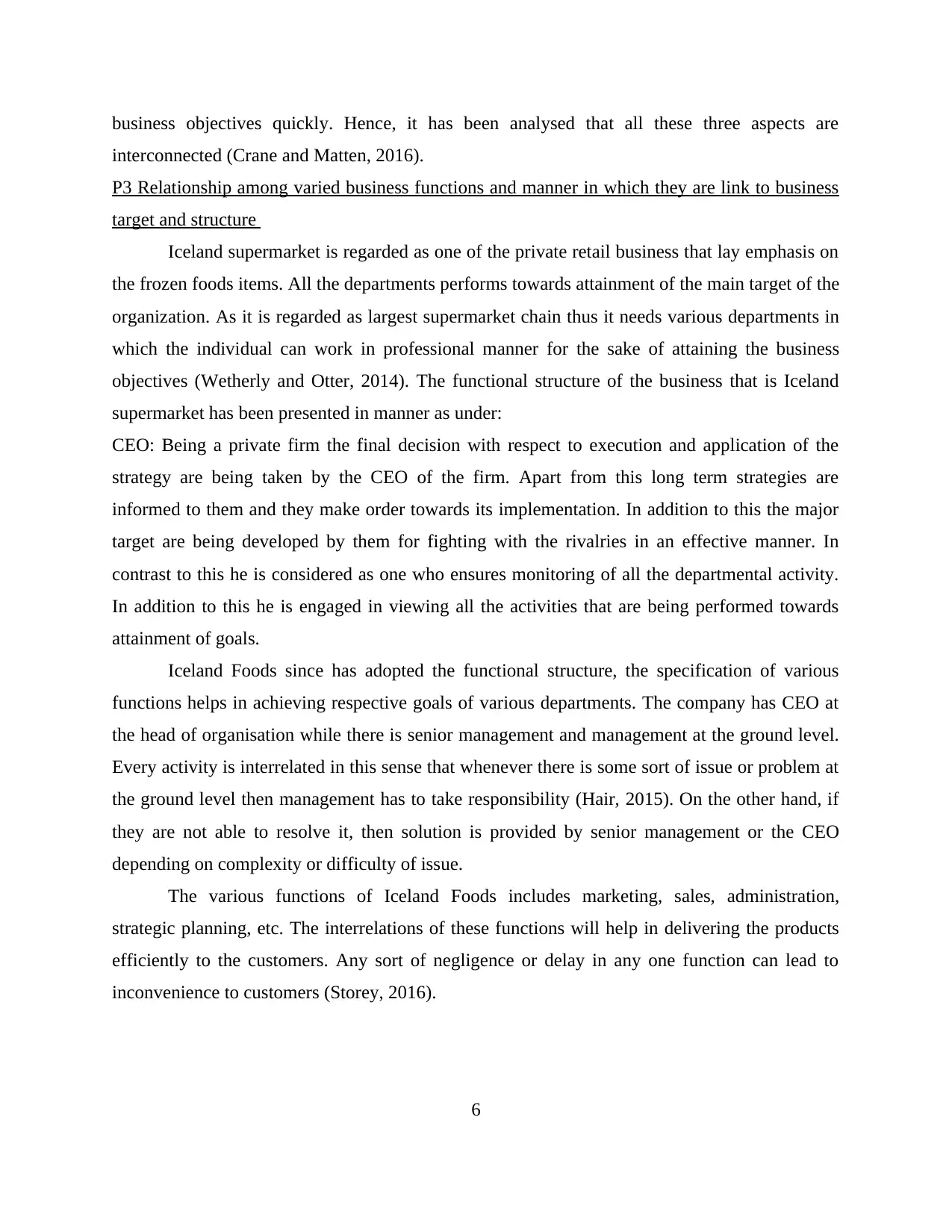
business objectives quickly. Hence, it has been analysed that all these three aspects are
interconnected (Crane and Matten, 2016).
P3 Relationship among varied business functions and manner in which they are link to business
target and structure
Iceland supermarket is regarded as one of the private retail business that lay emphasis on
the frozen foods items. All the departments performs towards attainment of the main target of the
organization. As it is regarded as largest supermarket chain thus it needs various departments in
which the individual can work in professional manner for the sake of attaining the business
objectives (Wetherly and Otter, 2014). The functional structure of the business that is Iceland
supermarket has been presented in manner as under:
CEO: Being a private firm the final decision with respect to execution and application of the
strategy are being taken by the CEO of the firm. Apart from this long term strategies are
informed to them and they make order towards its implementation. In addition to this the major
target are being developed by them for fighting with the rivalries in an effective manner. In
contrast to this he is considered as one who ensures monitoring of all the departmental activity.
In addition to this he is engaged in viewing all the activities that are being performed towards
attainment of goals.
Iceland Foods since has adopted the functional structure, the specification of various
functions helps in achieving respective goals of various departments. The company has CEO at
the head of organisation while there is senior management and management at the ground level.
Every activity is interrelated in this sense that whenever there is some sort of issue or problem at
the ground level then management has to take responsibility (Hair, 2015). On the other hand, if
they are not able to resolve it, then solution is provided by senior management or the CEO
depending on complexity or difficulty of issue.
The various functions of Iceland Foods includes marketing, sales, administration,
strategic planning, etc. The interrelations of these functions will help in delivering the products
efficiently to the customers. Any sort of negligence or delay in any one function can lead to
inconvenience to customers (Storey, 2016).
6
interconnected (Crane and Matten, 2016).
P3 Relationship among varied business functions and manner in which they are link to business
target and structure
Iceland supermarket is regarded as one of the private retail business that lay emphasis on
the frozen foods items. All the departments performs towards attainment of the main target of the
organization. As it is regarded as largest supermarket chain thus it needs various departments in
which the individual can work in professional manner for the sake of attaining the business
objectives (Wetherly and Otter, 2014). The functional structure of the business that is Iceland
supermarket has been presented in manner as under:
CEO: Being a private firm the final decision with respect to execution and application of the
strategy are being taken by the CEO of the firm. Apart from this long term strategies are
informed to them and they make order towards its implementation. In addition to this the major
target are being developed by them for fighting with the rivalries in an effective manner. In
contrast to this he is considered as one who ensures monitoring of all the departmental activity.
In addition to this he is engaged in viewing all the activities that are being performed towards
attainment of goals.
Iceland Foods since has adopted the functional structure, the specification of various
functions helps in achieving respective goals of various departments. The company has CEO at
the head of organisation while there is senior management and management at the ground level.
Every activity is interrelated in this sense that whenever there is some sort of issue or problem at
the ground level then management has to take responsibility (Hair, 2015). On the other hand, if
they are not able to resolve it, then solution is provided by senior management or the CEO
depending on complexity or difficulty of issue.
The various functions of Iceland Foods includes marketing, sales, administration,
strategic planning, etc. The interrelations of these functions will help in delivering the products
efficiently to the customers. Any sort of negligence or delay in any one function can lead to
inconvenience to customers (Storey, 2016).
6
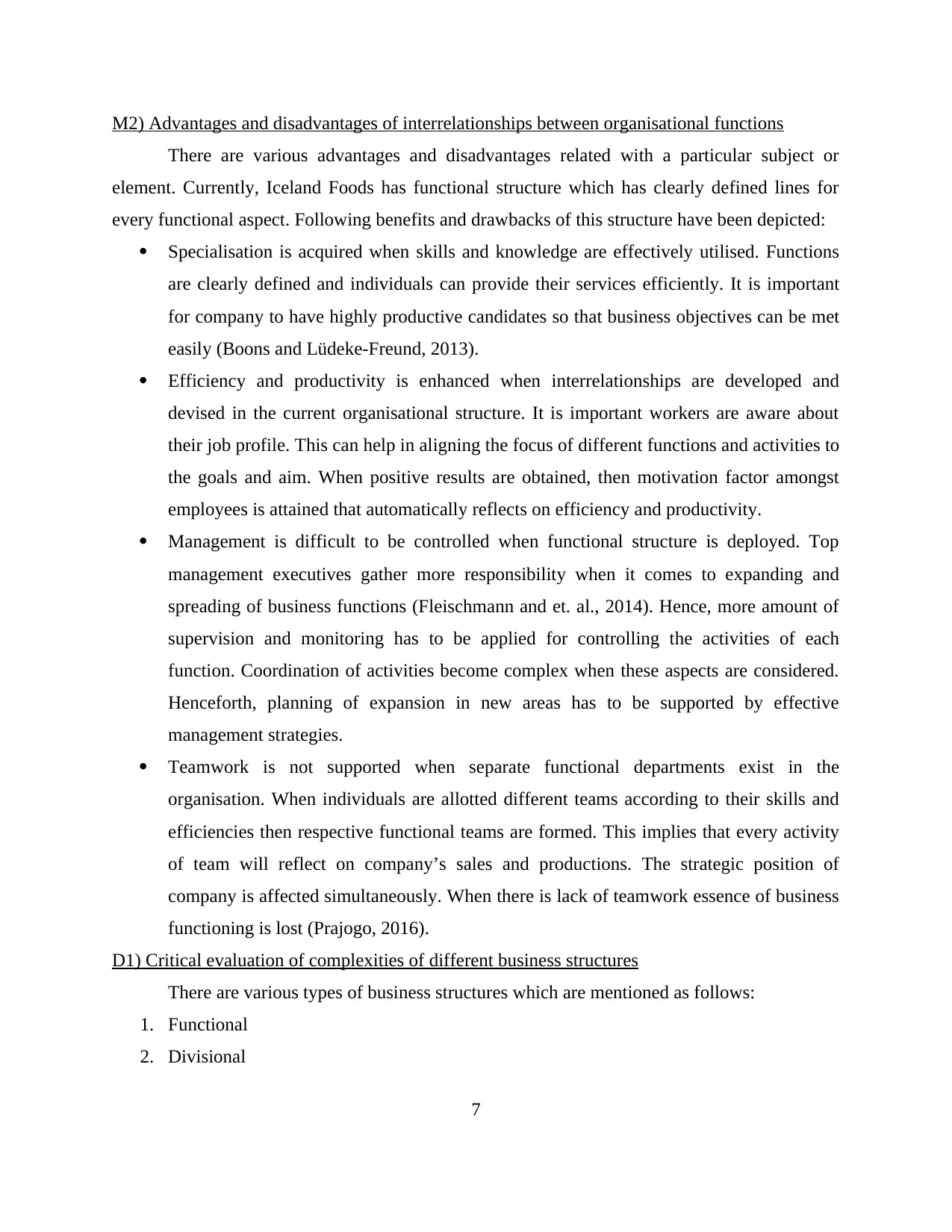
M2) Advantages and disadvantages of interrelationships between organisational functions
There are various advantages and disadvantages related with a particular subject or
element. Currently, Iceland Foods has functional structure which has clearly defined lines for
every functional aspect. Following benefits and drawbacks of this structure have been depicted:
Specialisation is acquired when skills and knowledge are effectively utilised. Functions
are clearly defined and individuals can provide their services efficiently. It is important
for company to have highly productive candidates so that business objectives can be met
easily (Boons and Lüdeke-Freund, 2013).
Efficiency and productivity is enhanced when interrelationships are developed and
devised in the current organisational structure. It is important workers are aware about
their job profile. This can help in aligning the focus of different functions and activities to
the goals and aim. When positive results are obtained, then motivation factor amongst
employees is attained that automatically reflects on efficiency and productivity.
Management is difficult to be controlled when functional structure is deployed. Top
management executives gather more responsibility when it comes to expanding and
spreading of business functions (Fleischmann and et. al., 2014). Hence, more amount of
supervision and monitoring has to be applied for controlling the activities of each
function. Coordination of activities become complex when these aspects are considered.
Henceforth, planning of expansion in new areas has to be supported by effective
management strategies.
Teamwork is not supported when separate functional departments exist in the
organisation. When individuals are allotted different teams according to their skills and
efficiencies then respective functional teams are formed. This implies that every activity
of team will reflect on company’s sales and productions. The strategic position of
company is affected simultaneously. When there is lack of teamwork essence of business
functioning is lost (Prajogo, 2016).
D1) Critical evaluation of complexities of different business structures
There are various types of business structures which are mentioned as follows:
1. Functional
2. Divisional
7
There are various advantages and disadvantages related with a particular subject or
element. Currently, Iceland Foods has functional structure which has clearly defined lines for
every functional aspect. Following benefits and drawbacks of this structure have been depicted:
Specialisation is acquired when skills and knowledge are effectively utilised. Functions
are clearly defined and individuals can provide their services efficiently. It is important
for company to have highly productive candidates so that business objectives can be met
easily (Boons and Lüdeke-Freund, 2013).
Efficiency and productivity is enhanced when interrelationships are developed and
devised in the current organisational structure. It is important workers are aware about
their job profile. This can help in aligning the focus of different functions and activities to
the goals and aim. When positive results are obtained, then motivation factor amongst
employees is attained that automatically reflects on efficiency and productivity.
Management is difficult to be controlled when functional structure is deployed. Top
management executives gather more responsibility when it comes to expanding and
spreading of business functions (Fleischmann and et. al., 2014). Hence, more amount of
supervision and monitoring has to be applied for controlling the activities of each
function. Coordination of activities become complex when these aspects are considered.
Henceforth, planning of expansion in new areas has to be supported by effective
management strategies.
Teamwork is not supported when separate functional departments exist in the
organisation. When individuals are allotted different teams according to their skills and
efficiencies then respective functional teams are formed. This implies that every activity
of team will reflect on company’s sales and productions. The strategic position of
company is affected simultaneously. When there is lack of teamwork essence of business
functioning is lost (Prajogo, 2016).
D1) Critical evaluation of complexities of different business structures
There are various types of business structures which are mentioned as follows:
1. Functional
2. Divisional
7
Paraphrase This Document
Need a fresh take? Get an instant paraphrase of this document with our AI Paraphraser
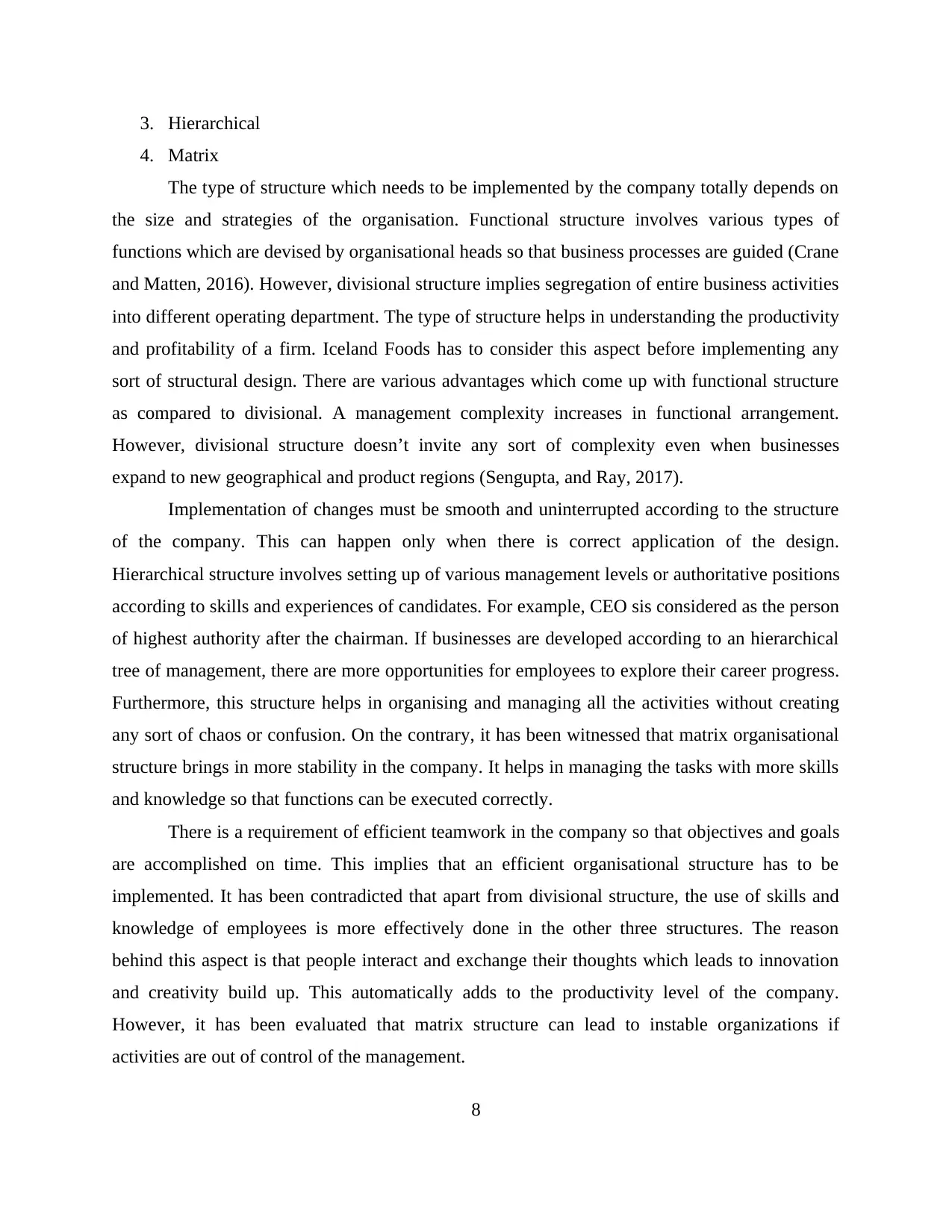
3. Hierarchical
4. Matrix
The type of structure which needs to be implemented by the company totally depends on
the size and strategies of the organisation. Functional structure involves various types of
functions which are devised by organisational heads so that business processes are guided (Crane
and Matten, 2016). However, divisional structure implies segregation of entire business activities
into different operating department. The type of structure helps in understanding the productivity
and profitability of a firm. Iceland Foods has to consider this aspect before implementing any
sort of structural design. There are various advantages which come up with functional structure
as compared to divisional. A management complexity increases in functional arrangement.
However, divisional structure doesn’t invite any sort of complexity even when businesses
expand to new geographical and product regions (Sengupta, and Ray, 2017).
Implementation of changes must be smooth and uninterrupted according to the structure
of the company. This can happen only when there is correct application of the design.
Hierarchical structure involves setting up of various management levels or authoritative positions
according to skills and experiences of candidates. For example, CEO sis considered as the person
of highest authority after the chairman. If businesses are developed according to an hierarchical
tree of management, there are more opportunities for employees to explore their career progress.
Furthermore, this structure helps in organising and managing all the activities without creating
any sort of chaos or confusion. On the contrary, it has been witnessed that matrix organisational
structure brings in more stability in the company. It helps in managing the tasks with more skills
and knowledge so that functions can be executed correctly.
There is a requirement of efficient teamwork in the company so that objectives and goals
are accomplished on time. This implies that an efficient organisational structure has to be
implemented. It has been contradicted that apart from divisional structure, the use of skills and
knowledge of employees is more effectively done in the other three structures. The reason
behind this aspect is that people interact and exchange their thoughts which leads to innovation
and creativity build up. This automatically adds to the productivity level of the company.
However, it has been evaluated that matrix structure can lead to instable organizations if
activities are out of control of the management.
8
4. Matrix
The type of structure which needs to be implemented by the company totally depends on
the size and strategies of the organisation. Functional structure involves various types of
functions which are devised by organisational heads so that business processes are guided (Crane
and Matten, 2016). However, divisional structure implies segregation of entire business activities
into different operating department. The type of structure helps in understanding the productivity
and profitability of a firm. Iceland Foods has to consider this aspect before implementing any
sort of structural design. There are various advantages which come up with functional structure
as compared to divisional. A management complexity increases in functional arrangement.
However, divisional structure doesn’t invite any sort of complexity even when businesses
expand to new geographical and product regions (Sengupta, and Ray, 2017).
Implementation of changes must be smooth and uninterrupted according to the structure
of the company. This can happen only when there is correct application of the design.
Hierarchical structure involves setting up of various management levels or authoritative positions
according to skills and experiences of candidates. For example, CEO sis considered as the person
of highest authority after the chairman. If businesses are developed according to an hierarchical
tree of management, there are more opportunities for employees to explore their career progress.
Furthermore, this structure helps in organising and managing all the activities without creating
any sort of chaos or confusion. On the contrary, it has been witnessed that matrix organisational
structure brings in more stability in the company. It helps in managing the tasks with more skills
and knowledge so that functions can be executed correctly.
There is a requirement of efficient teamwork in the company so that objectives and goals
are accomplished on time. This implies that an efficient organisational structure has to be
implemented. It has been contradicted that apart from divisional structure, the use of skills and
knowledge of employees is more effectively done in the other three structures. The reason
behind this aspect is that people interact and exchange their thoughts which leads to innovation
and creativity build up. This automatically adds to the productivity level of the company.
However, it has been evaluated that matrix structure can lead to instable organizations if
activities are out of control of the management.
8
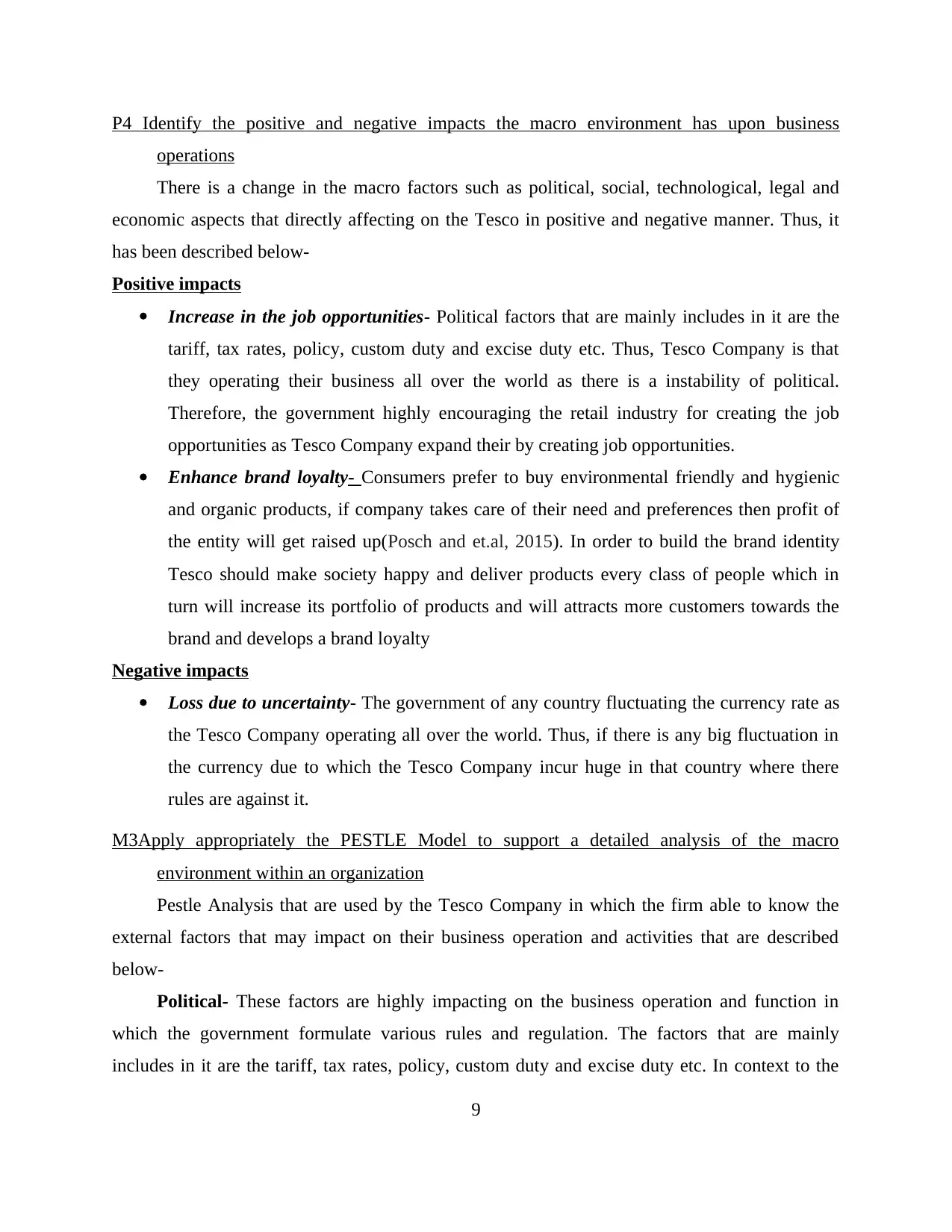
P4 Identify the positive and negative impacts the macro environment has upon business
operations
There is a change in the macro factors such as political, social, technological, legal and
economic aspects that directly affecting on the Tesco in positive and negative manner. Thus, it
has been described below-
Positive impacts
Increase in the job opportunities- Political factors that are mainly includes in it are the
tariff, tax rates, policy, custom duty and excise duty etc. Thus, Tesco Company is that
they operating their business all over the world as there is a instability of political.
Therefore, the government highly encouraging the retail industry for creating the job
opportunities as Tesco Company expand their by creating job opportunities.
Enhance brand loyalty- Consumers prefer to buy environmental friendly and hygienic
and organic products, if company takes care of their need and preferences then profit of
the entity will get raised up(Posch and et.al, 2015). In order to build the brand identity
Tesco should make society happy and deliver products every class of people which in
turn will increase its portfolio of products and will attracts more customers towards the
brand and develops a brand loyalty
Negative impacts
Loss due to uncertainty- The government of any country fluctuating the currency rate as
the Tesco Company operating all over the world. Thus, if there is any big fluctuation in
the currency due to which the Tesco Company incur huge in that country where there
rules are against it.
M3Apply appropriately the PESTLE Model to support a detailed analysis of the macro
environment within an organization
Pestle Analysis that are used by the Tesco Company in which the firm able to know the
external factors that may impact on their business operation and activities that are described
below-
Political- These factors are highly impacting on the business operation and function in
which the government formulate various rules and regulation. The factors that are mainly
includes in it are the tariff, tax rates, policy, custom duty and excise duty etc. In context to the
9
operations
There is a change in the macro factors such as political, social, technological, legal and
economic aspects that directly affecting on the Tesco in positive and negative manner. Thus, it
has been described below-
Positive impacts
Increase in the job opportunities- Political factors that are mainly includes in it are the
tariff, tax rates, policy, custom duty and excise duty etc. Thus, Tesco Company is that
they operating their business all over the world as there is a instability of political.
Therefore, the government highly encouraging the retail industry for creating the job
opportunities as Tesco Company expand their by creating job opportunities.
Enhance brand loyalty- Consumers prefer to buy environmental friendly and hygienic
and organic products, if company takes care of their need and preferences then profit of
the entity will get raised up(Posch and et.al, 2015). In order to build the brand identity
Tesco should make society happy and deliver products every class of people which in
turn will increase its portfolio of products and will attracts more customers towards the
brand and develops a brand loyalty
Negative impacts
Loss due to uncertainty- The government of any country fluctuating the currency rate as
the Tesco Company operating all over the world. Thus, if there is any big fluctuation in
the currency due to which the Tesco Company incur huge in that country where there
rules are against it.
M3Apply appropriately the PESTLE Model to support a detailed analysis of the macro
environment within an organization
Pestle Analysis that are used by the Tesco Company in which the firm able to know the
external factors that may impact on their business operation and activities that are described
below-
Political- These factors are highly impacting on the business operation and function in
which the government formulate various rules and regulation. The factors that are mainly
includes in it are the tariff, tax rates, policy, custom duty and excise duty etc. In context to the
9

Tesco Company is that they operating their business all over the world as there is a instability of
political. Therefore, the government highly encouraging the retail industry for creating the job
opportunities as Tesco Company expand their by creating job opportunities
Social- It is those aspects of business environment in which there is change in attitude of
customers, social custom, lifestyle, values and beliefs etc. It directly impact on the Tesco
Company business operations and their demand of customers regard to products or services.
therefore, these company deliver all those type of goods into the market which enhance the social
welfare and increase customer standard of living.
Technological- There is an advancement of technologies in the country as all company opt
these latest technology for the purpose of increase sales by offering the high quality products in
the market. In the retail industry company used the advance technologies for the purpose of
manufacturing the goods and promoting them into the potential target market. The Tesco
Company adopts the latest technology such as social media in which they promoting their
business over the online websites such as Facebook, Twitter, Instagram etc.
Legal- The government formulating the legislation and regulation in the various acts that
are highly affecting the business operation and activities. The government can change the rules
and laws of food due to which their business operations are highly impacting on its business
operations.
Economic- It is one of the most important aspect that impacting the company functions. It
majorly includes in it are the change in the monetary and fiscal policy. Thus it involves a
inflation rate, interest rate, CRR, SLR and fluctuation in foreign as well as domestic currency
rate. It will directly affecting the retail industry in terms of fluctuation in demands of their
products or services etc. For instance Tesco Company establish their business all over the world
in that they have to closely monitor the government policy due to which they set their pricing
strategies.
D2Critically evaluate the impacts that both macro and micro factors have upon business
objectives and decision making
The Tesco Company are majorly influence by internal external factor that which directly
impact on the business due to which company have to change their marketing as well as business
strategy. The micro factors that include employee in which there is any change in the attitude of
10
political. Therefore, the government highly encouraging the retail industry for creating the job
opportunities as Tesco Company expand their by creating job opportunities
Social- It is those aspects of business environment in which there is change in attitude of
customers, social custom, lifestyle, values and beliefs etc. It directly impact on the Tesco
Company business operations and their demand of customers regard to products or services.
therefore, these company deliver all those type of goods into the market which enhance the social
welfare and increase customer standard of living.
Technological- There is an advancement of technologies in the country as all company opt
these latest technology for the purpose of increase sales by offering the high quality products in
the market. In the retail industry company used the advance technologies for the purpose of
manufacturing the goods and promoting them into the potential target market. The Tesco
Company adopts the latest technology such as social media in which they promoting their
business over the online websites such as Facebook, Twitter, Instagram etc.
Legal- The government formulating the legislation and regulation in the various acts that
are highly affecting the business operation and activities. The government can change the rules
and laws of food due to which their business operations are highly impacting on its business
operations.
Economic- It is one of the most important aspect that impacting the company functions. It
majorly includes in it are the change in the monetary and fiscal policy. Thus it involves a
inflation rate, interest rate, CRR, SLR and fluctuation in foreign as well as domestic currency
rate. It will directly affecting the retail industry in terms of fluctuation in demands of their
products or services etc. For instance Tesco Company establish their business all over the world
in that they have to closely monitor the government policy due to which they set their pricing
strategies.
D2Critically evaluate the impacts that both macro and micro factors have upon business
objectives and decision making
The Tesco Company are majorly influence by internal external factor that which directly
impact on the business due to which company have to change their marketing as well as business
strategy. The micro factors that include employee in which there is any change in the attitude of
10
Secure Best Marks with AI Grader
Need help grading? Try our AI Grader for instant feedback on your assignments.
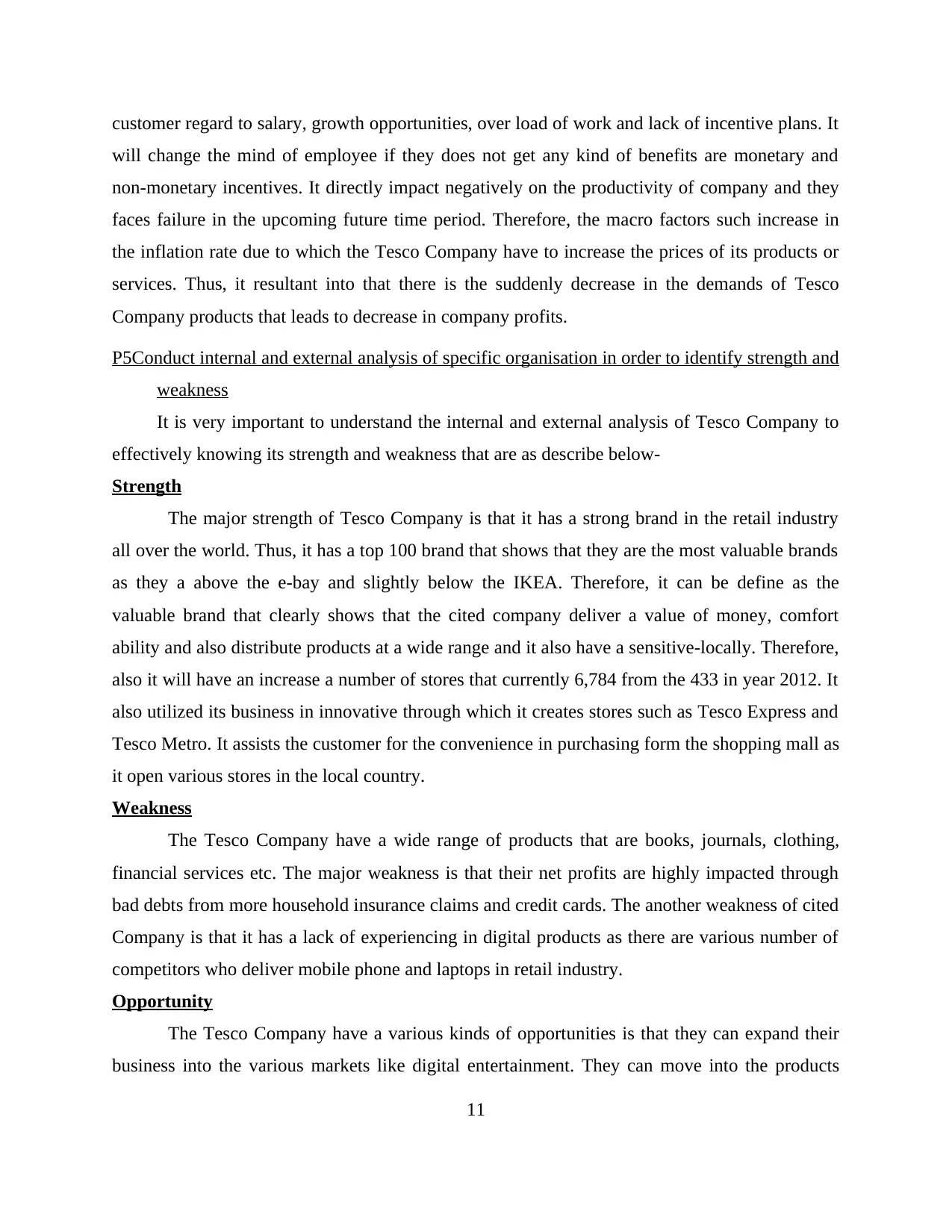
customer regard to salary, growth opportunities, over load of work and lack of incentive plans. It
will change the mind of employee if they does not get any kind of benefits are monetary and
non-monetary incentives. It directly impact negatively on the productivity of company and they
faces failure in the upcoming future time period. Therefore, the macro factors such increase in
the inflation rate due to which the Tesco Company have to increase the prices of its products or
services. Thus, it resultant into that there is the suddenly decrease in the demands of Tesco
Company products that leads to decrease in company profits.
P5Conduct internal and external analysis of specific organisation in order to identify strength and
weakness
It is very important to understand the internal and external analysis of Tesco Company to
effectively knowing its strength and weakness that are as describe below-
Strength
The major strength of Tesco Company is that it has a strong brand in the retail industry
all over the world. Thus, it has a top 100 brand that shows that they are the most valuable brands
as they a above the e-bay and slightly below the IKEA. Therefore, it can be define as the
valuable brand that clearly shows that the cited company deliver a value of money, comfort
ability and also distribute products at a wide range and it also have a sensitive-locally. Therefore,
also it will have an increase a number of stores that currently 6,784 from the 433 in year 2012. It
also utilized its business in innovative through which it creates stores such as Tesco Express and
Tesco Metro. It assists the customer for the convenience in purchasing form the shopping mall as
it open various stores in the local country.
Weakness
The Tesco Company have a wide range of products that are books, journals, clothing,
financial services etc. The major weakness is that their net profits are highly impacted through
bad debts from more household insurance claims and credit cards. The another weakness of cited
Company is that it has a lack of experiencing in digital products as there are various number of
competitors who deliver mobile phone and laptops in retail industry.
Opportunity
The Tesco Company have a various kinds of opportunities is that they can expand their
business into the various markets like digital entertainment. They can move into the products
11
will change the mind of employee if they does not get any kind of benefits are monetary and
non-monetary incentives. It directly impact negatively on the productivity of company and they
faces failure in the upcoming future time period. Therefore, the macro factors such increase in
the inflation rate due to which the Tesco Company have to increase the prices of its products or
services. Thus, it resultant into that there is the suddenly decrease in the demands of Tesco
Company products that leads to decrease in company profits.
P5Conduct internal and external analysis of specific organisation in order to identify strength and
weakness
It is very important to understand the internal and external analysis of Tesco Company to
effectively knowing its strength and weakness that are as describe below-
Strength
The major strength of Tesco Company is that it has a strong brand in the retail industry
all over the world. Thus, it has a top 100 brand that shows that they are the most valuable brands
as they a above the e-bay and slightly below the IKEA. Therefore, it can be define as the
valuable brand that clearly shows that the cited company deliver a value of money, comfort
ability and also distribute products at a wide range and it also have a sensitive-locally. Therefore,
also it will have an increase a number of stores that currently 6,784 from the 433 in year 2012. It
also utilized its business in innovative through which it creates stores such as Tesco Express and
Tesco Metro. It assists the customer for the convenience in purchasing form the shopping mall as
it open various stores in the local country.
Weakness
The Tesco Company have a wide range of products that are books, journals, clothing,
financial services etc. The major weakness is that their net profits are highly impacted through
bad debts from more household insurance claims and credit cards. The another weakness of cited
Company is that it has a lack of experiencing in digital products as there are various number of
competitors who deliver mobile phone and laptops in retail industry.
Opportunity
The Tesco Company have a various kinds of opportunities is that they can expand their
business into the various markets like digital entertainment. They can move into the products
11
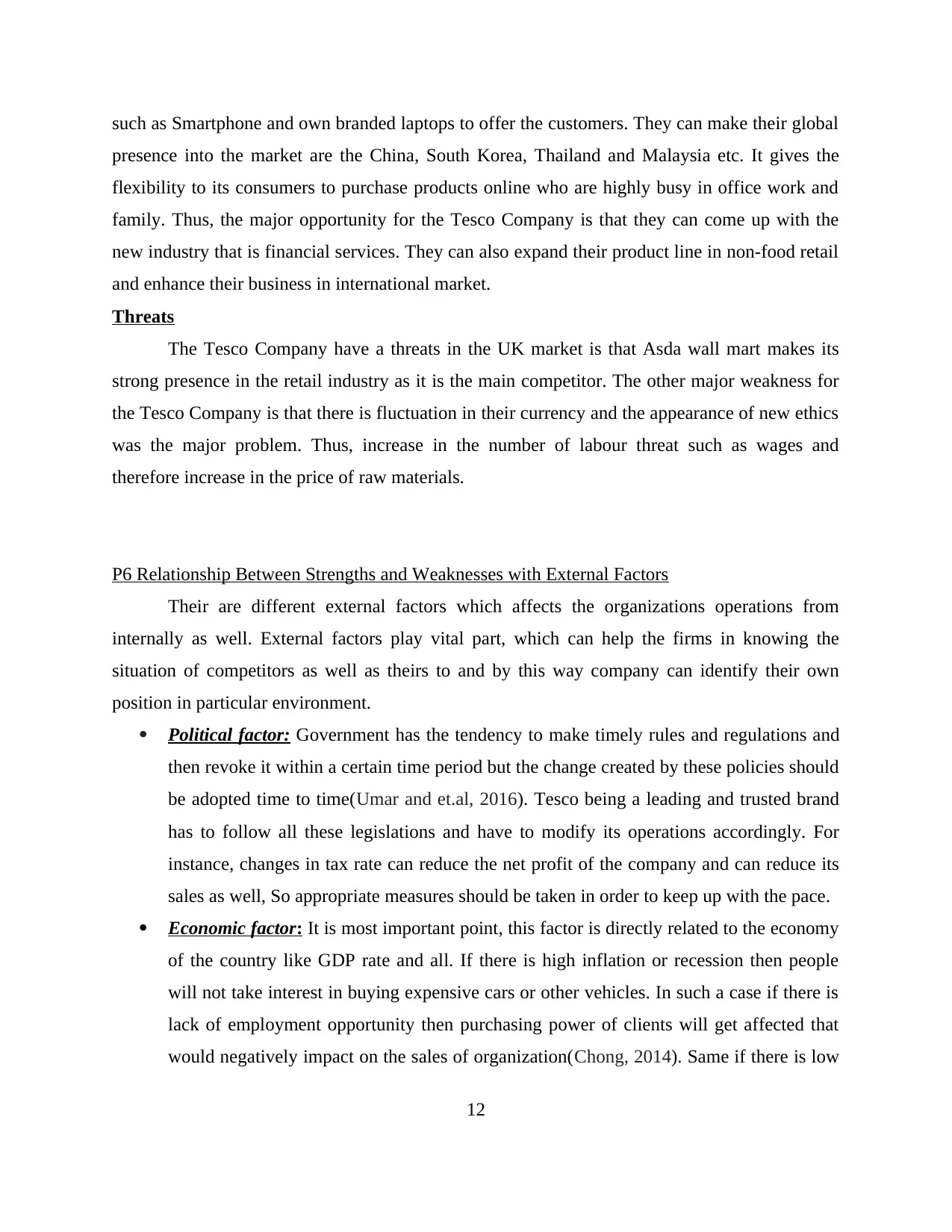
such as Smartphone and own branded laptops to offer the customers. They can make their global
presence into the market are the China, South Korea, Thailand and Malaysia etc. It gives the
flexibility to its consumers to purchase products online who are highly busy in office work and
family. Thus, the major opportunity for the Tesco Company is that they can come up with the
new industry that is financial services. They can also expand their product line in non-food retail
and enhance their business in international market.
Threats
The Tesco Company have a threats in the UK market is that Asda wall mart makes its
strong presence in the retail industry as it is the main competitor. The other major weakness for
the Tesco Company is that there is fluctuation in their currency and the appearance of new ethics
was the major problem. Thus, increase in the number of labour threat such as wages and
therefore increase in the price of raw materials.
P6 Relationship Between Strengths and Weaknesses with External Factors
Their are different external factors which affects the organizations operations from
internally as well. External factors play vital part, which can help the firms in knowing the
situation of competitors as well as theirs to and by this way company can identify their own
position in particular environment.
Political factor: Government has the tendency to make timely rules and regulations and
then revoke it within a certain time period but the change created by these policies should
be adopted time to time(Umar and et.al, 2016). Tesco being a leading and trusted brand
has to follow all these legislations and have to modify its operations accordingly. For
instance, changes in tax rate can reduce the net profit of the company and can reduce its
sales as well, So appropriate measures should be taken in order to keep up with the pace.
Economic factor: It is most important point, this factor is directly related to the economy
of the country like GDP rate and all. If there is high inflation or recession then people
will not take interest in buying expensive cars or other vehicles. In such a case if there is
lack of employment opportunity then purchasing power of clients will get affected that
would negatively impact on the sales of organization(Chong, 2014). Same if there is low
12
presence into the market are the China, South Korea, Thailand and Malaysia etc. It gives the
flexibility to its consumers to purchase products online who are highly busy in office work and
family. Thus, the major opportunity for the Tesco Company is that they can come up with the
new industry that is financial services. They can also expand their product line in non-food retail
and enhance their business in international market.
Threats
The Tesco Company have a threats in the UK market is that Asda wall mart makes its
strong presence in the retail industry as it is the main competitor. The other major weakness for
the Tesco Company is that there is fluctuation in their currency and the appearance of new ethics
was the major problem. Thus, increase in the number of labour threat such as wages and
therefore increase in the price of raw materials.
P6 Relationship Between Strengths and Weaknesses with External Factors
Their are different external factors which affects the organizations operations from
internally as well. External factors play vital part, which can help the firms in knowing the
situation of competitors as well as theirs to and by this way company can identify their own
position in particular environment.
Political factor: Government has the tendency to make timely rules and regulations and
then revoke it within a certain time period but the change created by these policies should
be adopted time to time(Umar and et.al, 2016). Tesco being a leading and trusted brand
has to follow all these legislations and have to modify its operations accordingly. For
instance, changes in tax rate can reduce the net profit of the company and can reduce its
sales as well, So appropriate measures should be taken in order to keep up with the pace.
Economic factor: It is most important point, this factor is directly related to the economy
of the country like GDP rate and all. If there is high inflation or recession then people
will not take interest in buying expensive cars or other vehicles. In such a case if there is
lack of employment opportunity then purchasing power of clients will get affected that
would negatively impact on the sales of organization(Chong, 2014). Same if there is low
12
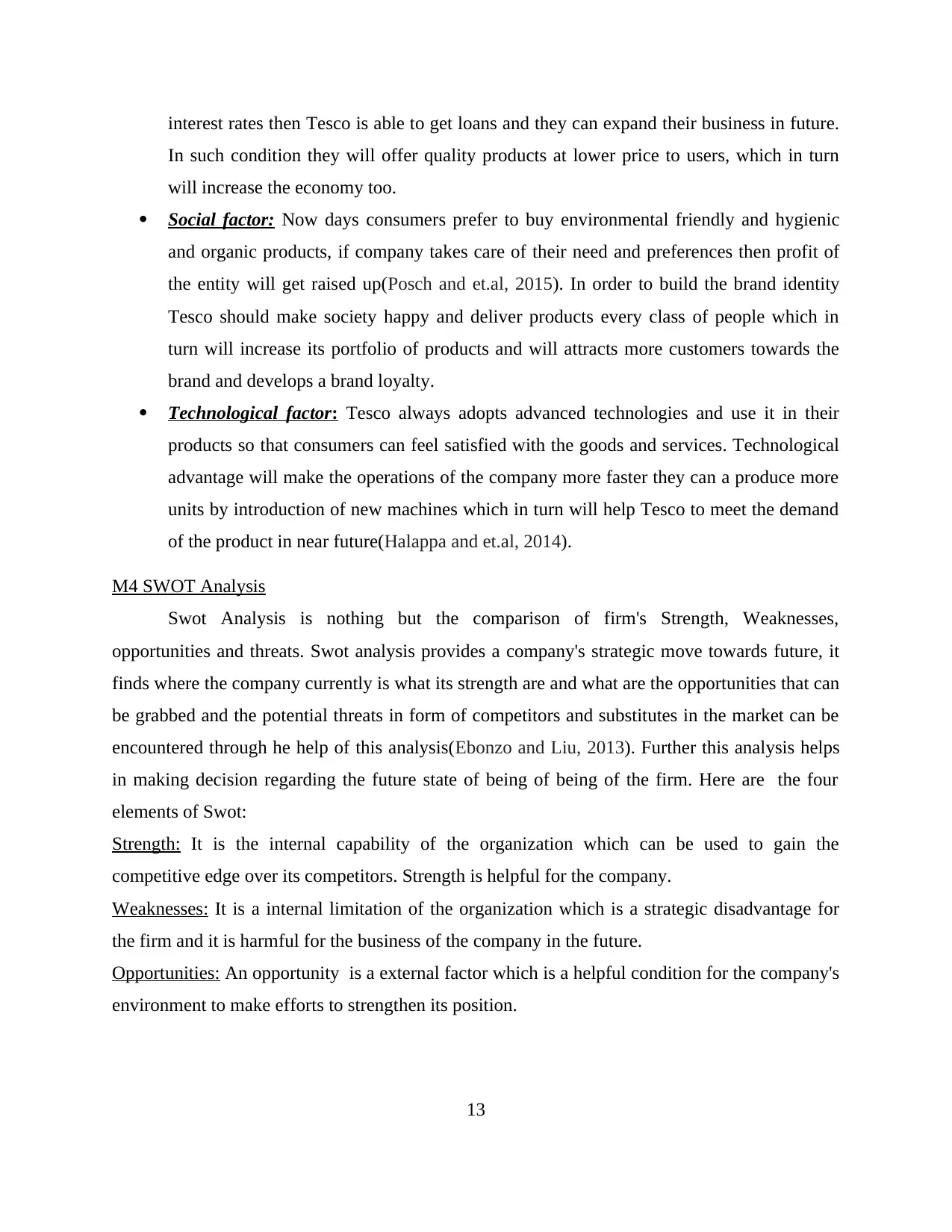
interest rates then Tesco is able to get loans and they can expand their business in future.
In such condition they will offer quality products at lower price to users, which in turn
will increase the economy too.
Social factor: Now days consumers prefer to buy environmental friendly and hygienic
and organic products, if company takes care of their need and preferences then profit of
the entity will get raised up(Posch and et.al, 2015). In order to build the brand identity
Tesco should make society happy and deliver products every class of people which in
turn will increase its portfolio of products and will attracts more customers towards the
brand and develops a brand loyalty.
Technological factor: Tesco always adopts advanced technologies and use it in their
products so that consumers can feel satisfied with the goods and services. Technological
advantage will make the operations of the company more faster they can a produce more
units by introduction of new machines which in turn will help Tesco to meet the demand
of the product in near future(Halappa and et.al, 2014).
M4 SWOT Analysis
Swot Analysis is nothing but the comparison of firm's Strength, Weaknesses,
opportunities and threats. Swot analysis provides a company's strategic move towards future, it
finds where the company currently is what its strength are and what are the opportunities that can
be grabbed and the potential threats in form of competitors and substitutes in the market can be
encountered through he help of this analysis(Ebonzo and Liu, 2013). Further this analysis helps
in making decision regarding the future state of being of being of the firm. Here are the four
elements of Swot:
Strength: It is the internal capability of the organization which can be used to gain the
competitive edge over its competitors. Strength is helpful for the company.
Weaknesses: It is a internal limitation of the organization which is a strategic disadvantage for
the firm and it is harmful for the business of the company in the future.
Opportunities: An opportunity is a external factor which is a helpful condition for the company's
environment to make efforts to strengthen its position.
13
In such condition they will offer quality products at lower price to users, which in turn
will increase the economy too.
Social factor: Now days consumers prefer to buy environmental friendly and hygienic
and organic products, if company takes care of their need and preferences then profit of
the entity will get raised up(Posch and et.al, 2015). In order to build the brand identity
Tesco should make society happy and deliver products every class of people which in
turn will increase its portfolio of products and will attracts more customers towards the
brand and develops a brand loyalty.
Technological factor: Tesco always adopts advanced technologies and use it in their
products so that consumers can feel satisfied with the goods and services. Technological
advantage will make the operations of the company more faster they can a produce more
units by introduction of new machines which in turn will help Tesco to meet the demand
of the product in near future(Halappa and et.al, 2014).
M4 SWOT Analysis
Swot Analysis is nothing but the comparison of firm's Strength, Weaknesses,
opportunities and threats. Swot analysis provides a company's strategic move towards future, it
finds where the company currently is what its strength are and what are the opportunities that can
be grabbed and the potential threats in form of competitors and substitutes in the market can be
encountered through he help of this analysis(Ebonzo and Liu, 2013). Further this analysis helps
in making decision regarding the future state of being of being of the firm. Here are the four
elements of Swot:
Strength: It is the internal capability of the organization which can be used to gain the
competitive edge over its competitors. Strength is helpful for the company.
Weaknesses: It is a internal limitation of the organization which is a strategic disadvantage for
the firm and it is harmful for the business of the company in the future.
Opportunities: An opportunity is a external factor which is a helpful condition for the company's
environment to make efforts to strengthen its position.
13
Paraphrase This Document
Need a fresh take? Get an instant paraphrase of this document with our AI Paraphraser
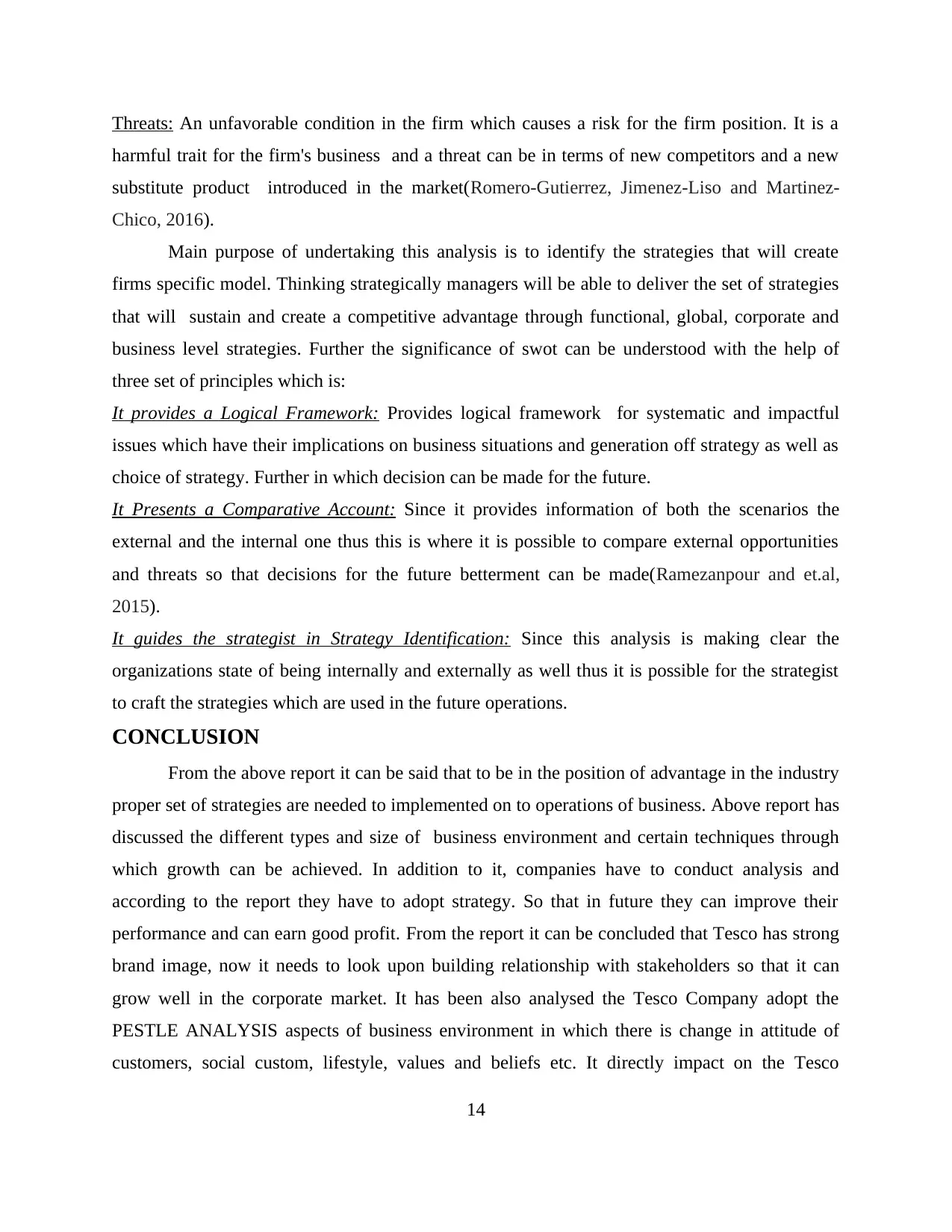
Threats: An unfavorable condition in the firm which causes a risk for the firm position. It is a
harmful trait for the firm's business and a threat can be in terms of new competitors and a new
substitute product introduced in the market(Romero-Gutierrez, Jimenez-Liso and Martinez-
Chico, 2016).
Main purpose of undertaking this analysis is to identify the strategies that will create
firms specific model. Thinking strategically managers will be able to deliver the set of strategies
that will sustain and create a competitive advantage through functional, global, corporate and
business level strategies. Further the significance of swot can be understood with the help of
three set of principles which is:
It provides a Logical Framework: Provides logical framework for systematic and impactful
issues which have their implications on business situations and generation off strategy as well as
choice of strategy. Further in which decision can be made for the future.
It Presents a Comparative Account: Since it provides information of both the scenarios the
external and the internal one thus this is where it is possible to compare external opportunities
and threats so that decisions for the future betterment can be made(Ramezanpour and et.al,
2015).
It guides the strategist in Strategy Identification: Since this analysis is making clear the
organizations state of being internally and externally as well thus it is possible for the strategist
to craft the strategies which are used in the future operations.
CONCLUSION
From the above report it can be said that to be in the position of advantage in the industry
proper set of strategies are needed to implemented on to operations of business. Above report has
discussed the different types and size of business environment and certain techniques through
which growth can be achieved. In addition to it, companies have to conduct analysis and
according to the report they have to adopt strategy. So that in future they can improve their
performance and can earn good profit. From the report it can be concluded that Tesco has strong
brand image, now it needs to look upon building relationship with stakeholders so that it can
grow well in the corporate market. It has been also analysed the Tesco Company adopt the
PESTLE ANALYSIS aspects of business environment in which there is change in attitude of
customers, social custom, lifestyle, values and beliefs etc. It directly impact on the Tesco
14
harmful trait for the firm's business and a threat can be in terms of new competitors and a new
substitute product introduced in the market(Romero-Gutierrez, Jimenez-Liso and Martinez-
Chico, 2016).
Main purpose of undertaking this analysis is to identify the strategies that will create
firms specific model. Thinking strategically managers will be able to deliver the set of strategies
that will sustain and create a competitive advantage through functional, global, corporate and
business level strategies. Further the significance of swot can be understood with the help of
three set of principles which is:
It provides a Logical Framework: Provides logical framework for systematic and impactful
issues which have their implications on business situations and generation off strategy as well as
choice of strategy. Further in which decision can be made for the future.
It Presents a Comparative Account: Since it provides information of both the scenarios the
external and the internal one thus this is where it is possible to compare external opportunities
and threats so that decisions for the future betterment can be made(Ramezanpour and et.al,
2015).
It guides the strategist in Strategy Identification: Since this analysis is making clear the
organizations state of being internally and externally as well thus it is possible for the strategist
to craft the strategies which are used in the future operations.
CONCLUSION
From the above report it can be said that to be in the position of advantage in the industry
proper set of strategies are needed to implemented on to operations of business. Above report has
discussed the different types and size of business environment and certain techniques through
which growth can be achieved. In addition to it, companies have to conduct analysis and
according to the report they have to adopt strategy. So that in future they can improve their
performance and can earn good profit. From the report it can be concluded that Tesco has strong
brand image, now it needs to look upon building relationship with stakeholders so that it can
grow well in the corporate market. It has been also analysed the Tesco Company adopt the
PESTLE ANALYSIS aspects of business environment in which there is change in attitude of
customers, social custom, lifestyle, values and beliefs etc. It directly impact on the Tesco
14

Company business operations and their demand of customers regard to products or services.
therefore, these company deliver all those type of goods into the market which enhance the social
welfare and increase customer standard of living.There is an advancement of technologies in the
country as all company opt these latest technology for the purpose of increase sales by offering
the high quality products in the market. In the retail industry company used the advance
technologies for the purpose of manufacturing the goods and promoting them into the potential
target market. The Tesco Company adopts the latest technology such as social media in which
they promoting their business over the online websites such as Facebook, Twitter, Instagram etc.
The government formulating the legislation and regulation in the various acts that are highly
affecting the business operation and activities. The government can change the rules and laws of
food due to which their business operations are highly impacting on its business operations.
Furthermore, it is not about making the strategies, rather implementation is the key and with that
comes roles and responsibilities of managers and decision making capabilities. Tesco Company
it has a top 100 brand that shows that they are the most valuable brands as they a above the e-bay
and slightly below the IKEA. Therefore, it can be define as the valuable brand that clearly shows
that the cited company deliver a value of money, comfort ability and also distribute products at a
wide range and it also have a sensitive-locally. Therefore, also it will have an increase a number
of stores that currently 6,784 from the 433 in year 2012. It also utilized its business in innovative
through which it creates stores such as Tesco Express and Tesco Metro. It assists the customer
for the convenience in purchasing form the shopping mall as it open various stores in the local
country.
15
therefore, these company deliver all those type of goods into the market which enhance the social
welfare and increase customer standard of living.There is an advancement of technologies in the
country as all company opt these latest technology for the purpose of increase sales by offering
the high quality products in the market. In the retail industry company used the advance
technologies for the purpose of manufacturing the goods and promoting them into the potential
target market. The Tesco Company adopts the latest technology such as social media in which
they promoting their business over the online websites such as Facebook, Twitter, Instagram etc.
The government formulating the legislation and regulation in the various acts that are highly
affecting the business operation and activities. The government can change the rules and laws of
food due to which their business operations are highly impacting on its business operations.
Furthermore, it is not about making the strategies, rather implementation is the key and with that
comes roles and responsibilities of managers and decision making capabilities. Tesco Company
it has a top 100 brand that shows that they are the most valuable brands as they a above the e-bay
and slightly below the IKEA. Therefore, it can be define as the valuable brand that clearly shows
that the cited company deliver a value of money, comfort ability and also distribute products at a
wide range and it also have a sensitive-locally. Therefore, also it will have an increase a number
of stores that currently 6,784 from the 433 in year 2012. It also utilized its business in innovative
through which it creates stores such as Tesco Express and Tesco Metro. It assists the customer
for the convenience in purchasing form the shopping mall as it open various stores in the local
country.
15
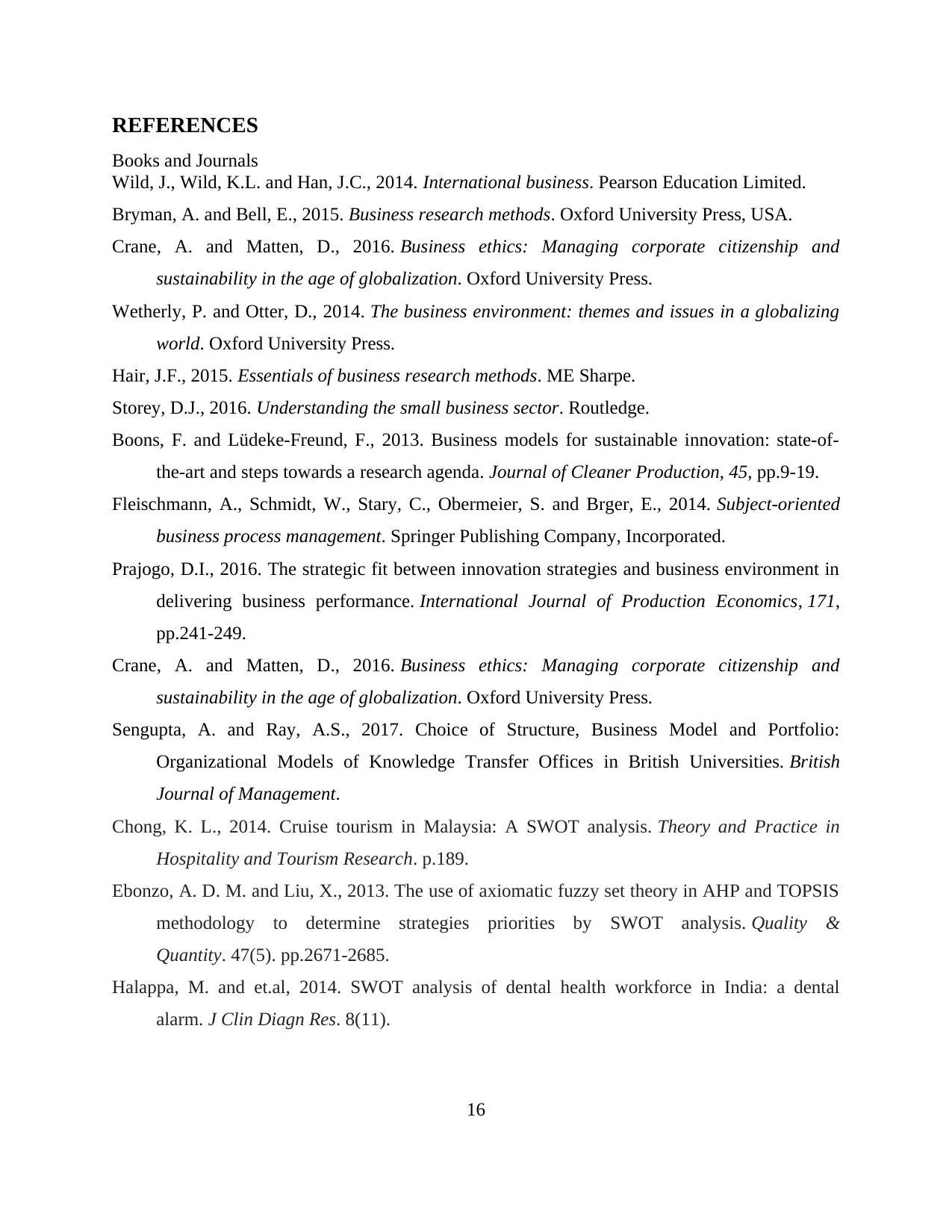
REFERENCES
Books and Journals
Wild, J., Wild, K.L. and Han, J.C., 2014. International business. Pearson Education Limited.
Bryman, A. and Bell, E., 2015. Business research methods. Oxford University Press, USA.
Crane, A. and Matten, D., 2016. Business ethics: Managing corporate citizenship and
sustainability in the age of globalization. Oxford University Press.
Wetherly, P. and Otter, D., 2014. The business environment: themes and issues in a globalizing
world. Oxford University Press.
Hair, J.F., 2015. Essentials of business research methods. ME Sharpe.
Storey, D.J., 2016. Understanding the small business sector. Routledge.
Boons, F. and Lüdeke-Freund, F., 2013. Business models for sustainable innovation: state-of-
the-art and steps towards a research agenda. Journal of Cleaner Production, 45, pp.9-19.
Fleischmann, A., Schmidt, W., Stary, C., Obermeier, S. and Brger, E., 2014. Subject-oriented
business process management. Springer Publishing Company, Incorporated.
Prajogo, D.I., 2016. The strategic fit between innovation strategies and business environment in
delivering business performance. International Journal of Production Economics, 171,
pp.241-249.
Crane, A. and Matten, D., 2016. Business ethics: Managing corporate citizenship and
sustainability in the age of globalization. Oxford University Press.
Sengupta, A. and Ray, A.S., 2017. Choice of Structure, Business Model and Portfolio:
Organizational Models of Knowledge Transfer Offices in British Universities. British
Journal of Management.
Chong, K. L., 2014. Cruise tourism in Malaysia: A SWOT analysis. Theory and Practice in
Hospitality and Tourism Research. p.189.
Ebonzo, A. D. M. and Liu, X., 2013. The use of axiomatic fuzzy set theory in AHP and TOPSIS
methodology to determine strategies priorities by SWOT analysis. Quality &
Quantity. 47(5). pp.2671-2685.
Halappa, M. and et.al, 2014. SWOT analysis of dental health workforce in India: a dental
alarm. J Clin Diagn Res. 8(11).
16
Books and Journals
Wild, J., Wild, K.L. and Han, J.C., 2014. International business. Pearson Education Limited.
Bryman, A. and Bell, E., 2015. Business research methods. Oxford University Press, USA.
Crane, A. and Matten, D., 2016. Business ethics: Managing corporate citizenship and
sustainability in the age of globalization. Oxford University Press.
Wetherly, P. and Otter, D., 2014. The business environment: themes and issues in a globalizing
world. Oxford University Press.
Hair, J.F., 2015. Essentials of business research methods. ME Sharpe.
Storey, D.J., 2016. Understanding the small business sector. Routledge.
Boons, F. and Lüdeke-Freund, F., 2013. Business models for sustainable innovation: state-of-
the-art and steps towards a research agenda. Journal of Cleaner Production, 45, pp.9-19.
Fleischmann, A., Schmidt, W., Stary, C., Obermeier, S. and Brger, E., 2014. Subject-oriented
business process management. Springer Publishing Company, Incorporated.
Prajogo, D.I., 2016. The strategic fit between innovation strategies and business environment in
delivering business performance. International Journal of Production Economics, 171,
pp.241-249.
Crane, A. and Matten, D., 2016. Business ethics: Managing corporate citizenship and
sustainability in the age of globalization. Oxford University Press.
Sengupta, A. and Ray, A.S., 2017. Choice of Structure, Business Model and Portfolio:
Organizational Models of Knowledge Transfer Offices in British Universities. British
Journal of Management.
Chong, K. L., 2014. Cruise tourism in Malaysia: A SWOT analysis. Theory and Practice in
Hospitality and Tourism Research. p.189.
Ebonzo, A. D. M. and Liu, X., 2013. The use of axiomatic fuzzy set theory in AHP and TOPSIS
methodology to determine strategies priorities by SWOT analysis. Quality &
Quantity. 47(5). pp.2671-2685.
Halappa, M. and et.al, 2014. SWOT analysis of dental health workforce in India: a dental
alarm. J Clin Diagn Res. 8(11).
16
Secure Best Marks with AI Grader
Need help grading? Try our AI Grader for instant feedback on your assignments.
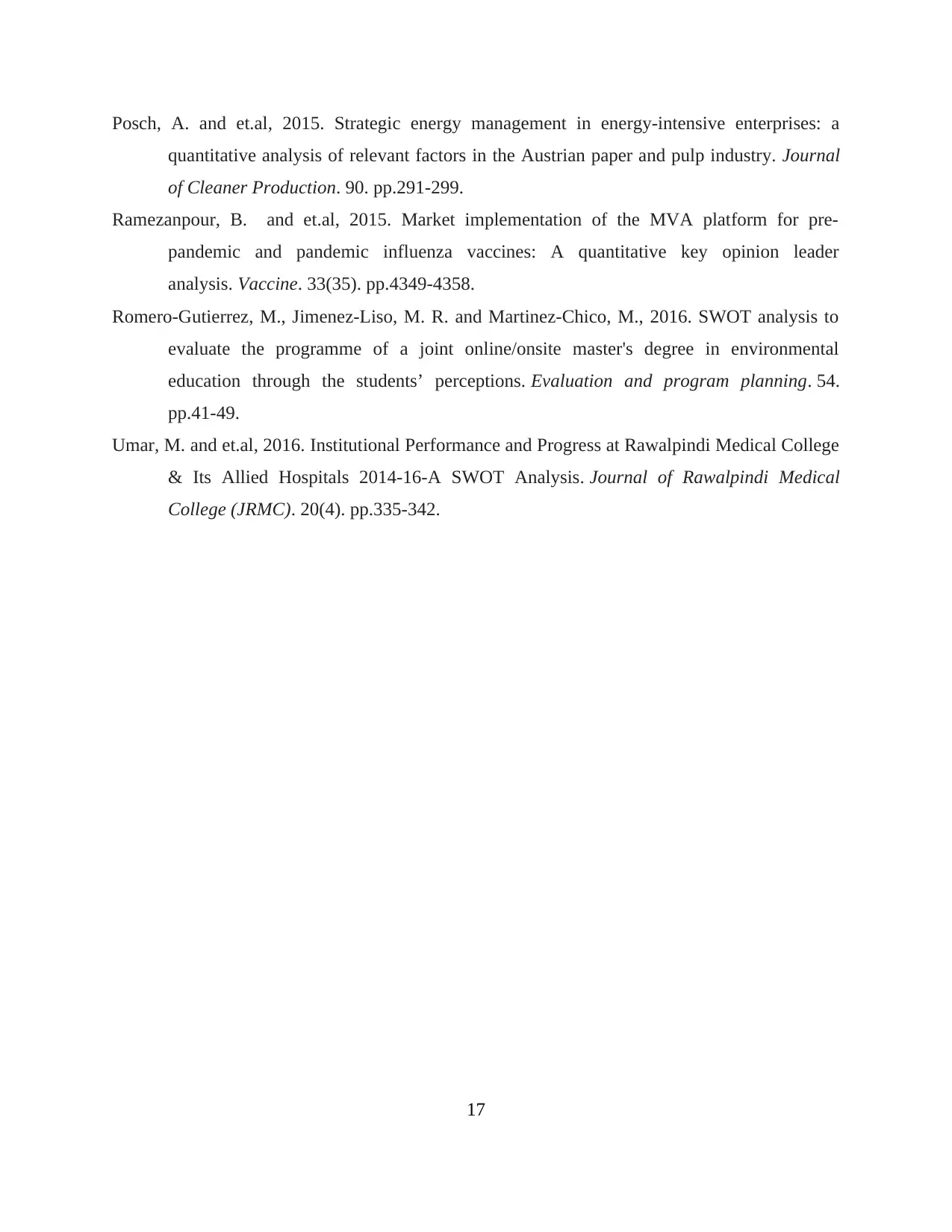
Posch, A. and et.al, 2015. Strategic energy management in energy-intensive enterprises: a
quantitative analysis of relevant factors in the Austrian paper and pulp industry. Journal
of Cleaner Production. 90. pp.291-299.
Ramezanpour, B. and et.al, 2015. Market implementation of the MVA platform for pre-
pandemic and pandemic influenza vaccines: A quantitative key opinion leader
analysis. Vaccine. 33(35). pp.4349-4358.
Romero-Gutierrez, M., Jimenez-Liso, M. R. and Martinez-Chico, M., 2016. SWOT analysis to
evaluate the programme of a joint online/onsite master's degree in environmental
education through the students’ perceptions. Evaluation and program planning. 54.
pp.41-49.
Umar, M. and et.al, 2016. Institutional Performance and Progress at Rawalpindi Medical College
& Its Allied Hospitals 2014-16-A SWOT Analysis. Journal of Rawalpindi Medical
College (JRMC). 20(4). pp.335-342.
17
quantitative analysis of relevant factors in the Austrian paper and pulp industry. Journal
of Cleaner Production. 90. pp.291-299.
Ramezanpour, B. and et.al, 2015. Market implementation of the MVA platform for pre-
pandemic and pandemic influenza vaccines: A quantitative key opinion leader
analysis. Vaccine. 33(35). pp.4349-4358.
Romero-Gutierrez, M., Jimenez-Liso, M. R. and Martinez-Chico, M., 2016. SWOT analysis to
evaluate the programme of a joint online/onsite master's degree in environmental
education through the students’ perceptions. Evaluation and program planning. 54.
pp.41-49.
Umar, M. and et.al, 2016. Institutional Performance and Progress at Rawalpindi Medical College
& Its Allied Hospitals 2014-16-A SWOT Analysis. Journal of Rawalpindi Medical
College (JRMC). 20(4). pp.335-342.
17
1 out of 17
Related Documents
Your All-in-One AI-Powered Toolkit for Academic Success.
+13062052269
info@desklib.com
Available 24*7 on WhatsApp / Email
![[object Object]](/_next/static/media/star-bottom.7253800d.svg)
Unlock your academic potential
© 2024 | Zucol Services PVT LTD | All rights reserved.





